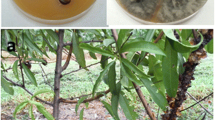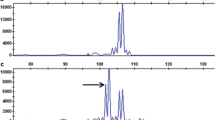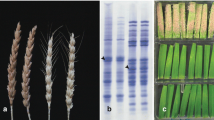Abstract
The study of the genetics of resistance in pepper to the oomycete pathogen Phytophthora capsici has been complicated due to a lack of use of a common set of pathogen isolates and host genotypes. We have developed a differential series for this system using eleven pepper genotypes and thirty-four isolates of the pathogen from California, New Mexico, North Carolina, and Turkey. Through differential patterns of virulence of the isolates on the hosts, we identified fourteen different physiological races of P. capsici. There appears to be no restriction of races to particular geographical locations. Isolate mating types were also determined, and both mating types were found in one field in California. The significance of the characterization of physiological races and existence of both mating types in the field to pepper growers and breeders is discussed.
Similar content being viewed by others
References
Barksdale TH, Papavizas GC, Johnston SA (1984) Resistance to foliar blight and crown rot of pepper caused by Phytophthora capsici. Plant Dis 68:506–509
Bosland PW, Lindsey DL (1991) A seedling screen for Phytophthora root rot of pepper, Capsicum annuum. Plant Dis 75:1048–1050
Engel SR, Descenzo RA, Irelan NA (2000) US patent #6,080,543. E & J Gallo Winery, Modesto, CA, June 27
Erwin DC (1983) Variability within and among species of Phytophthora. In: Erwin DC, Bartnicki-Garcia S, Tsao PH (eds) Phytophthora: its biology, taxonomy, ecology and pathology. American Pathological Society, St. Paul, MN
Erwin DC, Ribeiro OK (1996) Phytophthora diseases worldwide. American Phytopathological Society, St. Paul, MN
Jeffers SN, Martin SB (1986) Comparison of two media selective for Phytophthora and Pythium species. Plant Dis 70:1038–1043
Lamour KH, Hausbeck MK (2000) Mefenoxam insensitivity and the sexual stage of Phytophthora capsici in Michigan cucurbit fields. Phytopathology 90:396–400
Lamour KH, Hausbeck MK (2001) The dynamics of mefenoxam insensitivity in a recombining population of Phytophthora capsici characterized with amplified fragment length polymorphism markers. Phytopathology 91:553–557
Lefebvre V, Palloix A (1996) Both epistatic and additive effects of QTLs are involved in polygenic induced resistance to disease: a case study, the interaction pepper-Phytophthora capsici Leonian. Theor Appl Genet 93:503–511
Leonian LH (1922) Stem and fruit blight of peppers caused by Phytophthora capsici. Phytopathology 12:401–408
Oelke LM, Bosland PW, Steiner R (2003) Differentiation of race specific resistance to Phytophthora root rot and foliar blight in Capsicum annuum. J Am Soc Hortic Sci 128:213–218
Ogundiwin EA, Berke TF, Massoudi MA, Black LL, Huestis G, Choi D, Lee S, Prince JP (2005) Construction of 2 intraspecific linkage maps and identification of resistance QTLs for Phytophthora capsici root-rot and foliar-blight diseases of pepper (Capsicum annuum L.). Genome 48:698–711
Ortega RG, Espanol CP, Zueco JC (1992) Genetic relationships among four pepper genotypes resistant to Phytophthora capsici. Plant Breeding 108:118–125
Person C, Sidhu G (1971) Genetics of host-parasite interrelationships. In: Mutation breeding for disease resistance. International Atomic Energy Agency, Vienna
Reifschneider FJB, Boiteux LS, Vecchia PT, Poulos JM, Kuroda N (1992) Inheritance of adult-plant resistance to Phytophthora capsici in pepper. Euphytica 62:45–49
Ribeiro OK (1978) A source book for the genus Phytophthora. Strauss and Cramer GmBH, Germany
Ristaino JB, Madritch M, Trout C, Parra G (1998) PCR amplification of ribosomal DNA for species identification in the plant pathogen genus Phytophthora. Appl Environ Microbiol 64(3):948–954
Tyler BM (2002) Molecular basis of recognition between Phytophthora pathogens and their hosts. Ann Rev Phytopath 40:137–167
Acknowledgements
We would like to thank T. Day, M. Coffey, J. Ristaino, and P. Bosland for providing isolates of P. capsici, C. Sandlin, M. Massoudi, T. Berke, and K. Sakamoto for providing pepper accessions, J. Stebbins for greenhouse assistance, R. Heisey for advice on setting up the seedling screen, and J. Farrar for helpful comments throughout this project and critical reading of this manuscript. This work was supported by NIH-MBRS-SCORE, the California Pepper Commission, the CSU Agricultural Research Initiative (CSU-ARI), and the CSU Fresno College of Science and Mathematics.
Author information
Authors and Affiliations
Corresponding author
Rights and permissions
About this article
Cite this article
Glosier, B.R., Ogundiwin, E.A., Sidhu, G.S. et al. A differential series of pepper (Capsicum annuum) lines delineates fourteen physiological races of Phytophthora capsici . Euphytica 162, 23–30 (2008). https://doi.org/10.1007/s10681-007-9532-1
Received:
Accepted:
Published:
Issue Date:
DOI: https://doi.org/10.1007/s10681-007-9532-1




